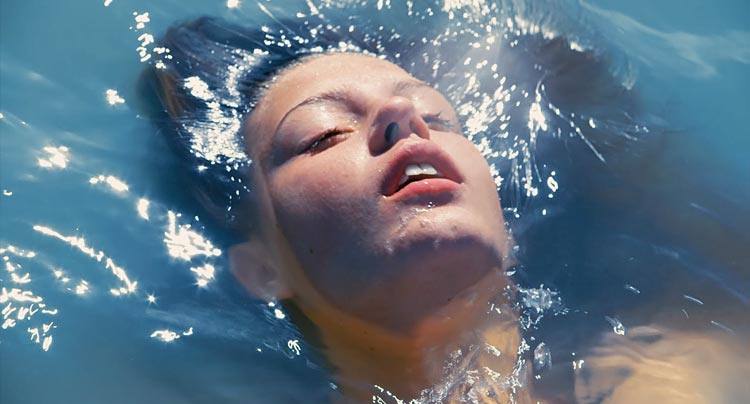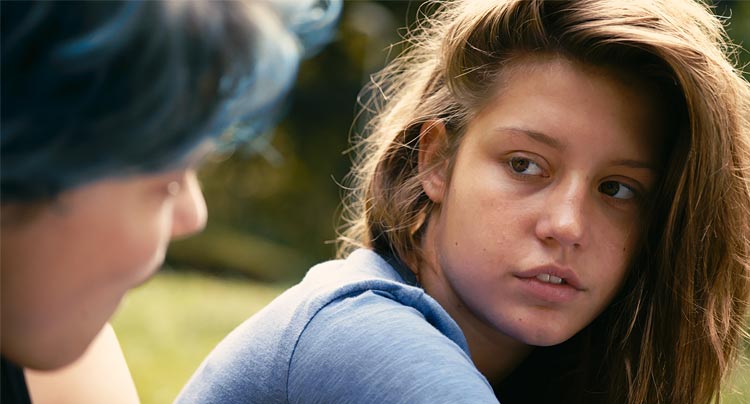
Among some of the best cinema has to offer this year. Masterful filmmaking.

Among some of the best cinema has to offer this year. Masterful filmmaking.
Was I a little upset that I did not catch Blue Is the Warmest Color while at the Cannes Film Festival earlier this year? Absolutely I was. Especially when the film went on to win the top prize of the Palme d’Or as well as awards for both leading actresses (a Cannes first). In my defense, it was not the most buzz generating film during the festival (Inside Llewyn Davis probably was), but the people I talked to who did see the film where generally blown away by it. Now having just watched it myself, I can see why.
Blue Is the Warmest Color begins with Adèle (Adèle Exarchopoulos) as a junior in high school who catches the eye of an attractive male in her school. The problem is her circle of friends seem much more interested in him than she does. They are the ones that encourage her to go on dates with him and then demand to hear the details afterwards. It is heartbreaking when Adèle begins to think that something is wrong with her because she has no feelings for him. When she cannot take it anymore and breaks down emotionally, so do we.
There is something that Adèle cannot stop thinking about—the girl with short blue hair (Léa Seydoux) that she once passed while crossing the street. Slowly but surely she begins to figure out that it was not specifically the guy she was seeing that she was not attracted towards, but males in general. With no help from her so-called friends (who tease and tell her names), Adèle decides to follow her urges of being with a woman instead of a man. Over the next few years of her life she will continue to have hills to climb and hurdles to jump over, no matter what her gender preference or relationship status is at the time.

This is every bit of a story about self-discovery as it is a story about love. While the story is quite good on its own, its effectiveness is only made possible by the amazing acting talent from both Adèle and Lea. Due to their tremendous performances, the fight that breaks out between the two leads late in the film very well may be the most emotionally charged scenes of the year. It is quite astonishing just how realistic and intimate the relationship between these two souls is represented on screen.
It is a real shame that the first thing you will likely hear about the film is the lesbian sex scenes and the gratuitous amounts of nudity. I say this because Blue Is the Warmest Color is a three-hour love story in which a ten-minute scene should not define it as a whole. Yes, there is a graphic sex scene involving two girls. Whether or not it goes on for a bit longer than it needed to is certainly up for debate, but the scene is not just thrown in haphazardly to boost ratings or as an excuse to show off the female body–it is part of the narrative between two passionate people who are madly in love with each other.
The amount of blue found throughout the film is not exactly surprising given the title. The most obvious instance is the color of Emma’s hair, but blue color is found all over. A blueish tint of light pulses in a gay bar where an overwhelming amount of people are wearing blue shirts. The bed sheets were blue where Adèle experiences her first sexual lesbian experience. At a gay pride parade, you guessed it, more blue. These visual themes add to the overall cinematical experience, but also serves as an essential part of symbolism in the story as it defines this time period of her life.

Same-sex marriage was still not legal in the country of France during the Cannes Film Festival where Blue Is the Warmest Color first premiered. On day 3 of the festival the bill was passed and France became the thirteenth country to permit same-sex marriage. Although this film had no direct influence on the ruling, you cannot help but see the how important and relevant the film’s subject matter is in these times. By no means is this the first pro gay or lesbian film, but it is certainly one of the most powerful to date.
To think of Abdellatif Kechiche’s Blue Is the Warmest Color as simply a lesbian love story is border-line insulting. Sure that serves as the underlying framework, but the film is equally, if not more, about the discovery of one’s own sexuality and the social pressures that are attached with it. It is remarkable that not only does the three-hour runtime never test your patience, but by the end the film actually leaves you wanting more. That alone is a testament of just how masterful the filmmaking, storytelling, and performances are in Blue Is the Warmest Color. In many ways the film is among some of the best cinema has to offer this year—every bit as poignant and rewarding as you could hope for a film to be.